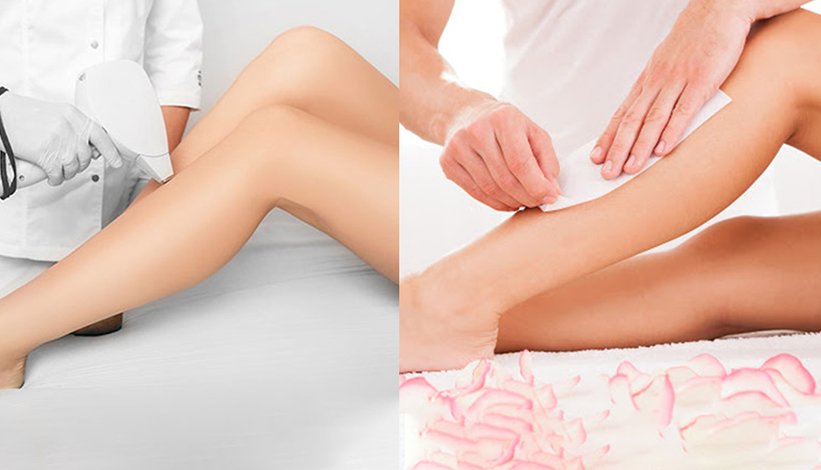Laser Hair Removal Vs. Traditional Methods: Which Is Right For You?
Unlike laser hair removal, which is fast and convenient, traditional hair reducing methods take a lot of time and are sometimes frustrating. You can temporarily remove hair with traditional methods such as shaving, waxing, sugaring, threading, and tweezing.
Laser hair removal is a permanent option for getting rid of unwanted hair and is effective, efficient, and quick. Every area of the body with unwanted hair can undergo laser hair removal.
Comparison of Laser Hair Removal and Traditional Methods
Laser Hair Removal
This is one of the procedures that lasts the longest, although it often calls for four or more treatments spaced four to six weeks apart.
A laser beam or a brief burst of light destroys the hair bulb. You can use the procedure on several body parts where unwanted hair grows, although it can be costly and occasionally uncomfortable. Be sure that the physician you choose has extensive training and knowledge.
Shaving
Everyone's first experience with hair removal is shaving. Leg, arm, and face hair are best removed with shaving. However, it can result in ingrown hairs, particularly in the pubic area.
Shaving temporarily removes hair from the skin's surface. Contrary to common perception, shaving doesn't thicken or darken the hair shaft. Moreover, it has no effect on the rate of hair growth.
Moisturize the skin before shaving for a smoother shave. Body wash, shaving cream, and hair conditioner all assist in making a razor glide over the skin more smoothly and less likely to cause bumps, cuts, and bruises.
Waxing
You can remove large quantities of hair quickly and effectively with waxing. Your skin is covered with warmed wax applied in the line of hair growth. When the wax cools, your hair becomes encased in it. A waxing strip is then placed on top of the wax and pulled off in the opposite direction of hair growth to remove the wax and hair from your skin.
While using hot wax, you must exercise great caution to prevent burns. Potential adverse effects include pain, rosy pimples, infection, pigmentation, ingrown hairs, and damage to skin.
Sugaring
Sugaring, commonly referred to as sugar waxing, is a common method of hair removal that functions similarly to regular waxing. A natural material with a viscosity like honey is applied on the skin against the direction of hair growth and then removed in the opposite direction. Sugaring does not involve the use of cloth or paper strips.
Cleaning up is the key benefit of sugaring over conventional waxing. Unlike regular wax, which may sometimes be a little more difficult to remove, you can wipe away sugaring with warm water.
Threading
A thin cotton or polyester thread is doubled, twisted, and rubbed over hair-growing areas to remove hair at the follicle level. Threading may remove short lines of hair as opposed to tweezing, which pulls out individual hairs one at a time.
Tweezing
Although using tweezers to pluck hair is an efficient method, it can take a lot of time. With a pair of tweezers, you can easily control loose facial hair, nose hair, and eyebrow hair.
Plucking or tweezing is an option worth considering if you simply need to get rid of a few hairs. You shouldn't apply this hair removal method to broad areas such as your back, chest or legs. Tweezing may result in scarring or ingrown hairs.
Factors to Consider Laser Hair Removal Vs. Traditional Methods
For most people, dealing with unwanted hair on all body parts is a tiresome daily task. Conventional procedures of hair removal are sometimes time-consuming, uncomfortable, and occasionally costly.
No matter how frequently you wax, shave, or use tweezers, the hair always reappears after a few hours or days. Thankfully, there is a hair removal method that is secure, efficient, economical, and best of all, long-lasting.
Skin Type
For laser skin treatments, laser and aesthetic experts will employ the Fitzpatrick scale. They can use the scale to assess how well lasers work on various skin types.
Similar to how various skin types respond to the sun, the power of the laser used is controlled by how the skin responds to the light. For instance, Fitzpatrick type 6 individuals are more susceptible to laser burns.
The predominant candidates with positive results are individuals with pale complexion and black, thick hair. If you have blond, red, or gray hair, it is recommended that you get an epilation.
Hair Type
Dark, coarse hair is the best hair type for laser hair removal. Dark hair type and pale skin provide a contrast that makes it simple to target the melanin. But when it comes to blond, gray, or red hair, waxing or epilation is preferable.
Budget
You won't need as many razors, shaving cream, waxing visits, etc. when you have laser hair removal treatments. As waxing has become more expensive, laser hair removal has become less expensive. Laser hair removal will save you money, take less time, and produce results that will last longer.
Think about the price of razor blades, shaving cream, and soothing aftershave lotion after each shave, over the course of a lifetime. Shaving won't stop hair growth, thus the expense will continue to climb.
Also, while waxing may make hair look less coarse, it doesn't actually reduce total hair growth and requires a continual financial commitment. Although laser hair removal treatments may seem expensive up front, they are inexpensive when compared to the recurring expenses of using traditional hair removal methods.
Pain Tolerance
For the most part, laser hair removal is comfortable. It doesn't hurt any worse than waxing. However, some technologies include cutting-edge cooling technology that functions on touch to safeguard the skin and guarantee a more comfortable procedure. The doctor can adjust the settings for your comfort if you have sensitive skin with minimal pain tolerance.
Choosing the Right Provider for Laser Hair Removal
Professional
While being a minimally invasive procedure, laser hair removal is still a medical procedure and has to be performed by a qualified practitioner. Be sure the expert performing or supervising the process has a valid license. Your physician should be knowledgeable, competent, self-assured, and professional.
Portfolio
The majority of clinics provide a portfolio of "before" and "after" photos of laser hair removal. Do read them through. Moreover, attempt to chat with patients who have received laser hair removal at the clinic to get a sense of how they felt about the personnel and services.
Reviews
Simple online research yields a list of nearby clinics, reviews left by former patients, and more. Reviews and other readily available information guide you to a fantastic laser hair removal clinic while keeping you safe.
Technology
Ensure the laser specialists employ the most advanced equipment, technology, and guidance on all of their operations, whether you select a laser hair removal clinic that focuses on laser hair removal or one that provides a range of aesthetic treatments.
Risks and Side Effects of Laser Hair Removal
Risks
Your skin will feel and seem sunburned for a day or two following the procedure. You can use cold compress and moisturizers for relief. Remember to apply sunscreen to prevent skin color changes for the next month.
Side Effects
In the early aftermath of the procedure, the laser may result in transient adverse effects. The most frequent adverse effects are skin irritability and pigmentation changes.
You may notice that your skin is a little bit lighter or darker after laser therapy. At the treated region, you may also experience a little bit of inflammation and redness. These impacts are nevertheless minimal. The symptoms are frequently the same as those you could experience following waxing or other hair removal methods.
To lessen these side effects, your aesthetic physician might advise you to stay away from sunlight a week before and after the procedure. Also, depending on the laser used, they may suggest the use of topical anesthetics.
However, within hours following the treatment, the general irritation should subside. If you suffer symptoms that go beyond mild irritation or if the adverse effects get worse, you should notify your doctor.
Conclusion
Laser hair removal treatment is generally considered to be safe. Also, the technique has no known long-term negative effects. Laser hair treatments, provided by a physician or other competent and skilled professional, function by preventing the follicles from producing new hair.
If you're sick of using conventional hair removal methods like shaving, laser hair removal provides a longer lasting, less stressful, and cost-effective solution.



